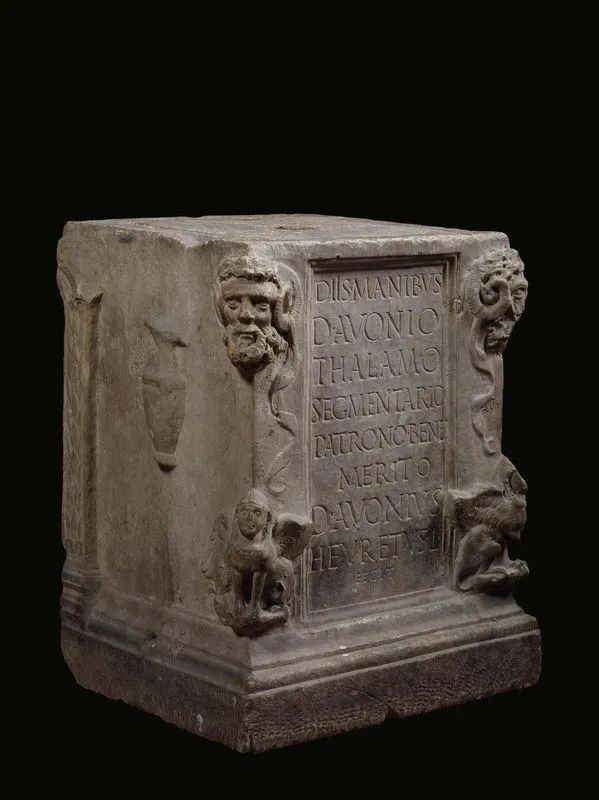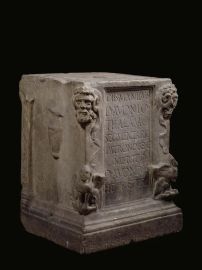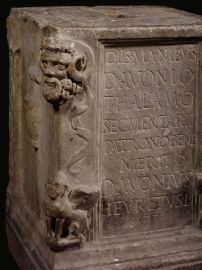ALTAR
ROMAN, 2ND TO 3RD CENTURY AD
Fine grain white marble, sculpted, polished, and finished off with using a drill, 58x46x42 cm
Bibliografia
G. Wilmans, Exempla inscriptionum latinarum in usum praecipue academicum, Berlino 1870, p. 172 n. 2542;
Corpus Inscriptionum Latinarum, vol. VI, Inscriptiones Urbis Romae Latinae, pars II, Berlino 1882, n. 9889;
H. Dessau, Inscriptiones Latinae Selectae Berlino 1906, vol. III, n. 7590
This altar is today missing its upper section; at the front, we find an inscription over nine lines:
diis manibus
d·avonio
thalamo
segmentario
patrono·bene
merito
d·avonius
heuretus·l·
fecit
To the Manes (and) to Decimus Avonius Thalamus, tailor, worthy master,
did Decimus Avonius Heuretus, freedman, build (this)
In the upper part on the edges we find two heads of Ammon, in his ram hypostasis, with thick hair and a curly beard, strongly marked in the visage’s deep chiaroscuro, and with large curved ram horns from which hang long tainies. On the lower edges we instead find harpies with lions’ bodies and women’s heads, large folded wings, depicted perching on their back legs whilst their front legs are erect. Their tails coil over the sides of the small monument. An oenochoe and a patera are sculpted in high relief on each side respectively, referencing the funerary libation honouring the dead. On both the back edges there is pilaster topped by an ionic capital, its trunk decorated by a motif of small lanceolate leaves. The base is molded.
Condition: lacking the upper part of the altar, whilst there are lacunae in the protome of Ammon and in the right harpy. There is a small lacuna in the base of the left pillar.
The epigraph of this small altar has been published three times: by Wilmas in 1870 in his Exempla inscriptionum latinarum in usum praecipue academicum, which locates it in Rome and specifies that it was described by Giovan Battista de Rossi and by Lanciani; then in 1873 in Corpus Inscriptionum Latinarum, vol. VI n. 9889 by Johann Heinrich Henzen, director of the Germanic Institute for Archaeological Correspondence in Rome, locating its provenance from the Corsi del Pinto vineyard between the cemetery of Callistus and the Church of Saint Sebastian; and finally by Dessau in 1906 in Inscriptiones Latinae Selectae.
It can thus be safely assumed that the altar, after being unearthed, was placed on the antiquities market where it was probably acquired by Baron Blanc to be later used not as a self-standing monument but as the basis for the statue of Artemis presented in the lot prior to this one.
As there are no ancient images of the altar in our possession, it is not possible to know whether the smoothing out of the upper part of the altar owes to its condition or whether it was purposefully carried out so as to obtain a surface which would almost perfectly correspond with the lower base of the statue of Artemis.








